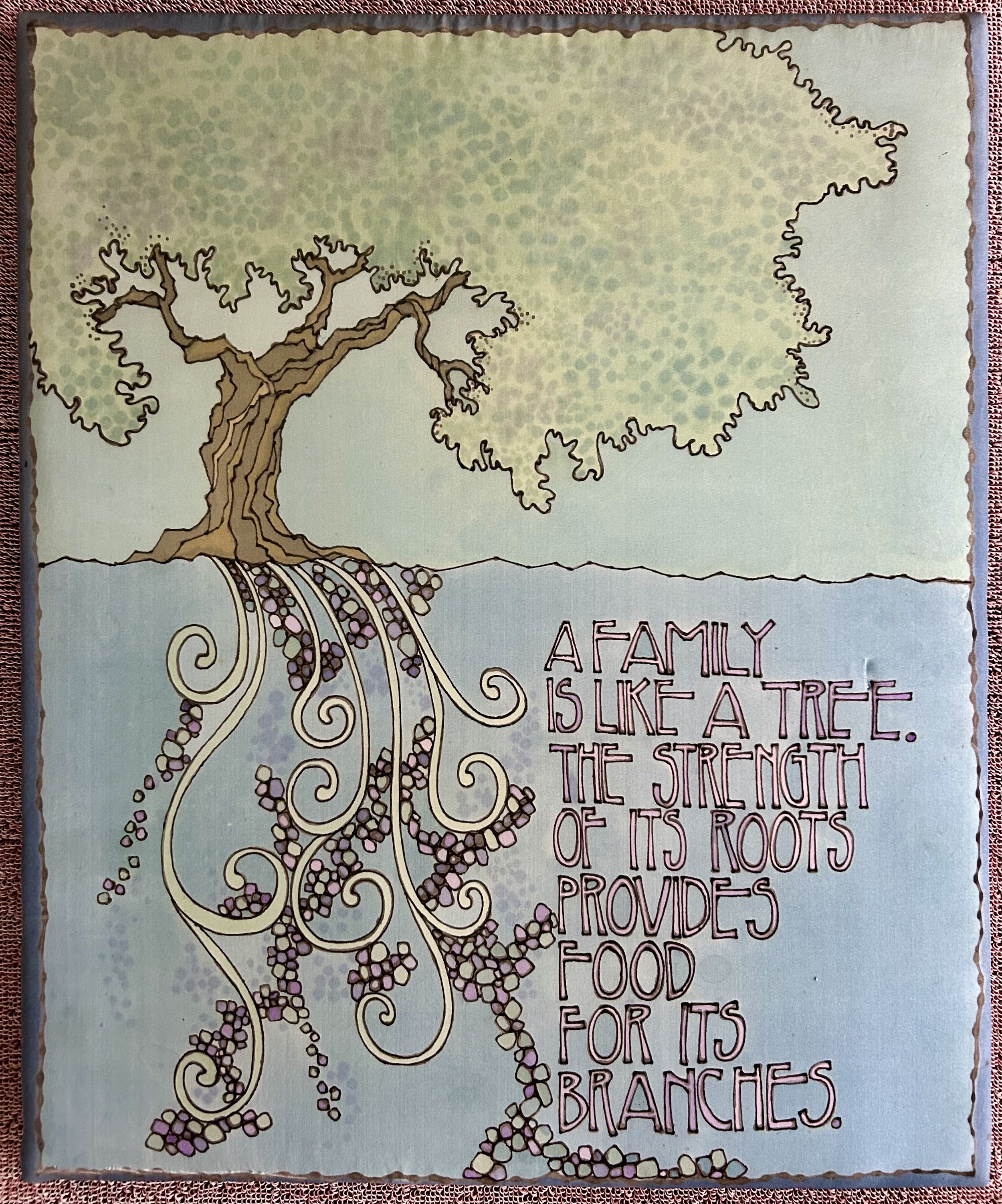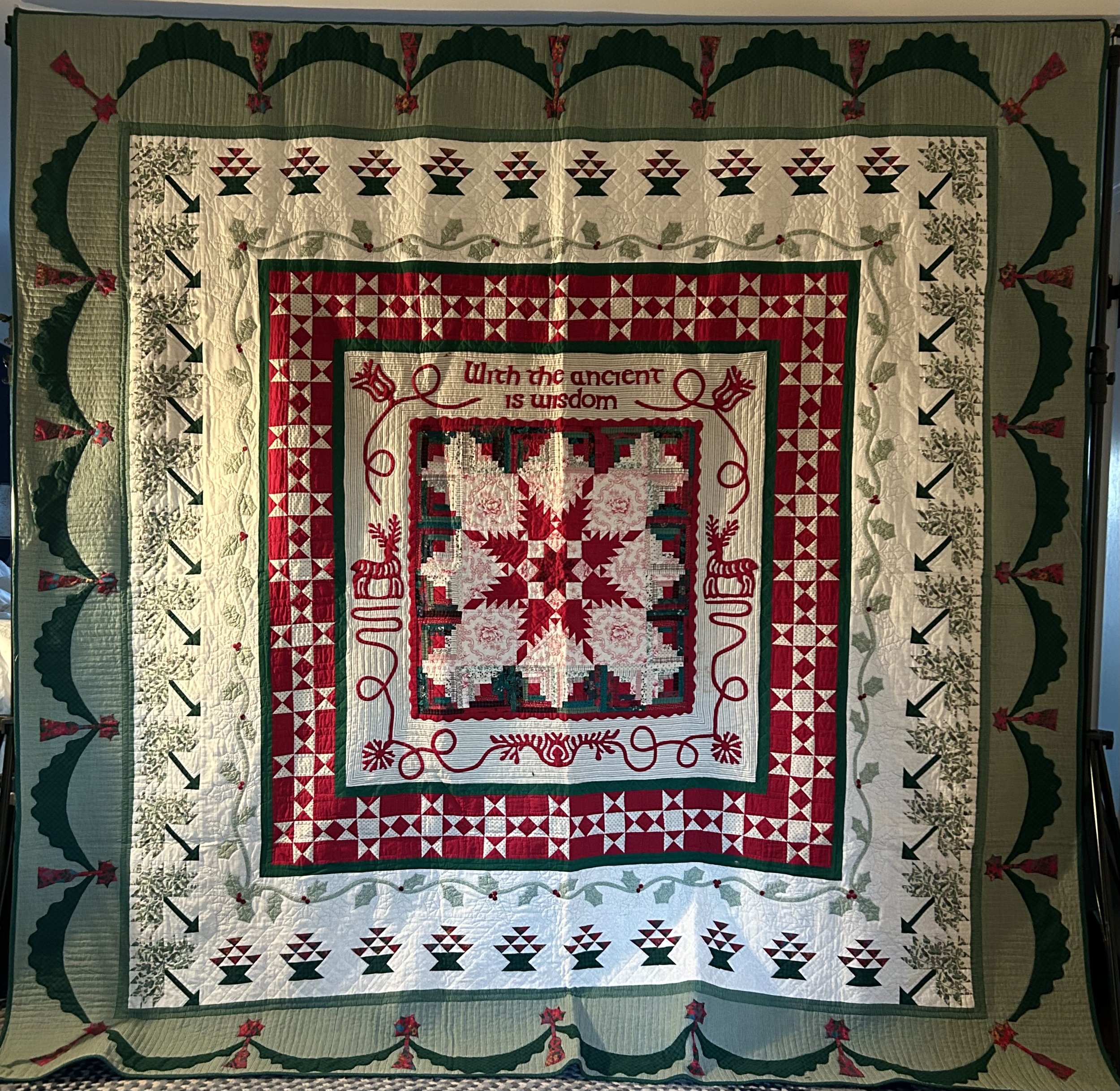Tree of Life
Ferreting through the Bins recently, I came across this piece. It is large, 19” x 23”, made of padded silk and mounted to a wood frame. The piece is not signed nor dated, and, given its weight, cost less than $3. Miraculously the silk was not torn, stained, or damaged. If you have been to a Bins thrift store, you understand how remarkable that is. If you have no clue what I’m talking about, here’s a photo I took recently of my two friends getting into the spirit of the place:
Thankfully, I found a card tucked into the wood framing which informed me the artist was Mary Jo Scandin, and her art medium was batik fabrics. Batik is an unusual art form, using wax and dye instead of paints to create works. She describes her process on the card:
“Each batik begins with a pencil drawing directly on a piece of white natural fabric. The area to remain white is then painted with a melted beeswax and paraffin mixture. The wax acts as a resist to the dyes which are to follow. The first dye bath is a light color and after it has dried, new areas will be painted with wax. The fabric is then dyed again, and the process repeated several times until the number of colors desired is obtained. Each piece is individually designed so no two pieces are ever alike.”
While I could not find much information about Mary Jo online, I learned she and her husband Jim ran an art studio and gallery in Sister Bay, WI, from 1983 until 2002. Blue Dolphin Gallery, also in Door County, now carries some of her work, and confirmed she is still alive. While the individual at the gallery was rather terse, their website has a quote from Mary Jo:
“Through my work I attempt to integrate my various identities of woman, mother, friend and artist with my associations to those women in our history who also spent time sewing, quilting, knitting and handling fibers…I am inspired in my work by the spirits of those who came before me, those whom I know presently and all others still to come. It is my desire to express my concern for truth, justice and peace and to challenge some of the stereotypes concerning the human condition and its relationship to the universe. My final hope is to express hope.” (https://www.bluedolphinhouse.com)
I have a sense of kinship with Mary Jo Scandin, as I too love the imagery of trees, and respect women’s needlework as an art form. I learned my sewing skills the old-fashioned way, from my mother, as well as quilting teachers and friends, and one of my early quilt projects paid homage to this. I “remembered” this quilt having a tree of life block in the center, but after looking at it, realized the tree imagery is in an outer border. The center block is actually a “feathered star”, composed of 164 pieces. The quilt was created through a workshop I took 30 years ago from Muriel Douglas, a remarkable quilt artist. The year-long class focused on the medallion-style quilts Muriel favored, and was held once a month at a quilt shop in Woodstock, IL. There were no patterns, we simply started with a block of our choosing, and built on it outward, border by border. The darn thing got huge, measuring 94” square. The 24 trees, in the second to last border, were pieced using a lovely Liberty fabric. As I only had so much of the green fabric, and couldn’t make more trees, I offset them with basket blocks using another red Liberty print. When I began the final swag border using that same red Liberty print, I realized I did not have enough fabric to complete the design. I contacted the archive at Liberty of London (didn’t actually know there WAS an archivist at Liberty until I started that process), and they sent me all they had of the fabric so I could complete my work. Heaven forbid some future Liberty of London archivist goes looking for that red fabric – it is now all embedded in my quilt!
I love the huge old trees on our property, and feel I am a caretaker to these living beings. I often transplant saplings - oaks, basswood, maples, redbuds, junipers - that pop up on our property, sometimes sharing them with friends. I plant them where they can thrive, with sun and protection from critters (who I have learned enjoy munching on many types of little trees). I schlep hoses to water the trees in hot weather, and spend much time pruning and shaping them to foster healthy growth. Sometimes I have to take down trees, especially those that grow too close to the house or get damaged in a storm. Sadly, many trees get attacked by bugs or fungi and that is yet another care taking project – providing chemicals to help them withstand the infestation. Watching an old tree succumb, no longer sprouting growth each Spring, is actually remarkably sad when you’ve lived with their beauty for so many years. It is not hard to recognize caring for trees is much like raising a child, with the hope you can provide enough care while they are young and growing strong roots, so they can stand on their own and thrive.
For me, the tree image represents our human connection, the ancestry that came before us, the branching of our “family tree”. I too have concern for truth, justice and peace in our lives. I see trees dying from a damaged environment, and worry the roots of our trees may not be strong enough to offer hope to future generations. But pessimism doesn’t do me any good, and I look to art, family and nature for comfort. Mary Jo Scandin was a serendipitous discovery, offering beauty and inspiration and reminding me that trees – like humans – have strong roots.



